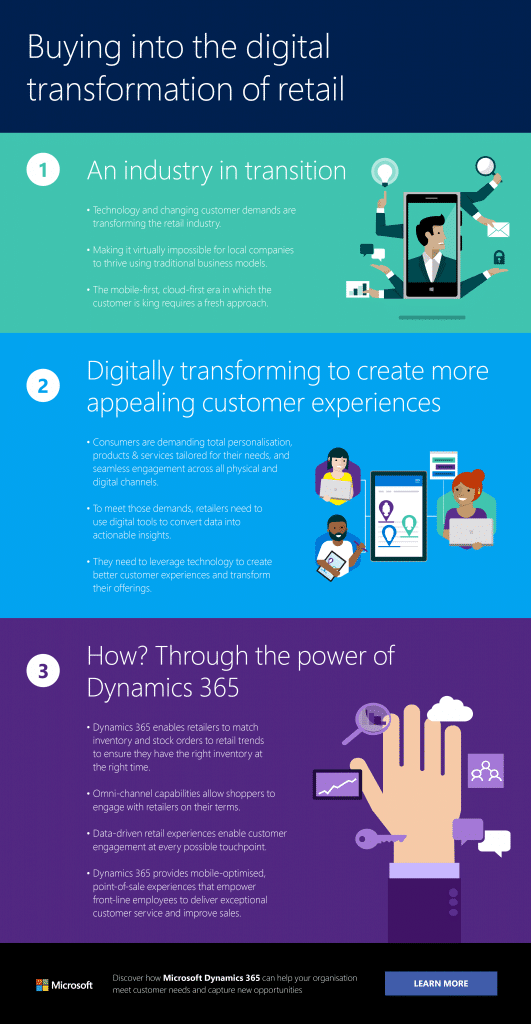By Kethan Pharboo, Chief Marketing and Operations Officer at Microsoft South Africa
Few could argue that South African retailers are having a torrid time. Faced with a slowing economy and an increasingly cautious consumer, many brick and mortar retailers are struggling to maintain healthy profit margins. Added to this, digital transformation is changing the entire retail playing field: new, online competitors are eating away at traditional market share, while digitally savvy consumers are continuously scanning for bargains and better prices. When combining all of these factors, it is clear that local retailers can no longer afford to apply the same strategies and operational approaches as before. They need to up the ante, on a variety of different levels.
Before taking a deep dive into specific areas where local retailers can boost consumer engagement and streamline efficiencies (particularly through digital), it is worth debunking the myth that ‘retail is dying’. In many circles, research reports and eye-catching headlines have rung the death knell for brick and mortar retailers (dubbed the ‘Retail Apocalypse’), claiming that e-commerce is the only way of the future. Yet even as slick and smart online stores woo younger shoppers via their ever present smartphones, we are undoubtedly seeing that consumers still seek out and enjoy the physical, in-store experience.
Today, many are going online to browse products and prices, and then walking into stores and shopping malls to make the final purchase. Notably, a recent study released by IHL found that in the United States, where e-commerce growth has been high and consumers are comfortable transacting online, traditional retail is very healthy. In that highly technology driven market where e-commerce giant Amazon has been looming large, retail sales are in fact up $121.5bn through the first seven months of 2017. Instead of ‘Retail Apocalypse’, the study found that the U.S. saw over 4,000 store openings in 2017, and 5,500 openings projected for 2018.
Creating Irresistible Customer Experiences
While the good news is that consumers still want in-store experiences, the ‘bad’ news is that traditional retailers have to act quickly in order to stay relevant and appealing in an increasingly crowded marketplace. Without doubt, they have to leverage digital tools and platforms to become more agile and responsive – and harness the reams of data now becoming available to them.
To begin with, retailers need to use digital tools to modernize and improve their operations on the back end. This will require looking more carefully at legacy systems and perhaps replacing them with new, Cloud based CRM and ERP software, for example.
When it comes to the front end, it is imperative to begin to draw on data based insights to transform and improve upon the actual products on offer. Some consumers may prefer an online option for certain products, while other product offerings are best suited for a carefully designed online display. Also, innovation is key in terms of broadening the scope of what retailers can offer. For example, some are now allowing consumers to pay their utility bills in-store and transfer money – such offerings undoubtedly open up key opportunities to both cross-sell and deepen customer loyalty.
Critically, the clever use of digital platforms can transform the existing customer experience and provide shoppers with more reasons to come in-store. Indeed, retailers must invest in the store experience at every level. This could mean using data to create loyalty programmes and gamified apps that augment the traditional experience, as well as using geo-location technology to target consumers in specific locations.
There is also an opportunity to approach advertising in a new way. In the past, when it came to in-retail ads, stores were little more than ‘venues for hire’. However, today’s newer location-based advertising business models allow stores themselves to be active partners in the advertising relationship.
For example, Impax Media, recently named the year’s “Most Disruptive” retail innovation by the Global Market Development Center, offers a solution for sponsored in-store video info-tainment that improves the least enjoyed part of the shopping journey: the dreaded checkout line. Using video screens placed above each checkout register, companies can advertise to customers while they wait in line, as the screens collect anonymous, attention-based data.
Finally, employees at retail stores need to be properly trained around the use of new digital platforms, and to handle the new ways of working that are quickly emerging. A critical element here is the use of mobile point of sale (POS) systems and NFC tools. In short, empowering employees along the route of digital transformation can make or break a retailer’s chance of long-term success in this new playing field.
A Tailored, Accessible Digital Solution for SA’s Modern Retailers
Having recognised that local retailers need access to new and innovative digital solutions, Microsoft has developed a product that addresses the main pain points that local retailers are currently grappling with. In essence, Dynamics 365 for Retail, a new intelligent cloud solution, provides retailers with an integrated end-to-end view of their operations.
Critically, it empowers retailers with centralised management and clear visibility across stores, employees, customers, inventory and financials. Key features of Dynamics 365 include mobile-optimised, point of sale experiences that empower front line employees to deliver exceptional customer service and improve sales; various omni-channel capabilities that allow shoppers to engage with retailers on their terms and to buy, fulfil and return anywhere; and data-driven retail experiences that enable customer engagement at every possible touch point. Notably, retailers can choose to deploy the solution on premises, online or by using hybrid scenarios with licensing flexibility. Also, by harnessing both Dynamics 365 and Office 365, retailers can harness prescriptive recommendations and automated data capture of customer communications – across both platforms.
Looking ahead, there is no doubt that SA’s retailers are under immense pressure to transform and innovate from within. The right digital solution can accelerate this much-needed transformation, and empower retailers to capitalise on the wholesale shift to a digital way of consuming products and services.



